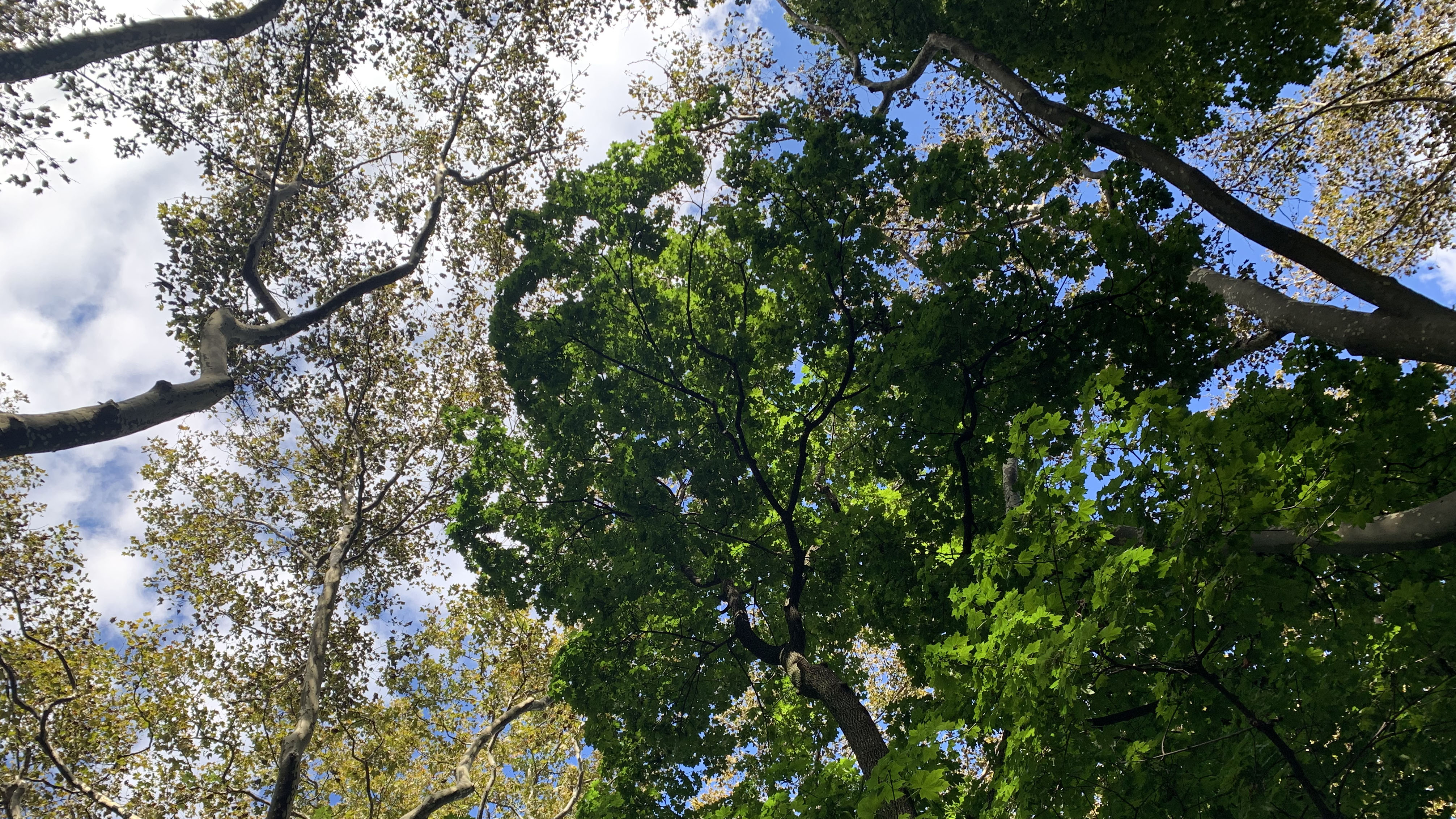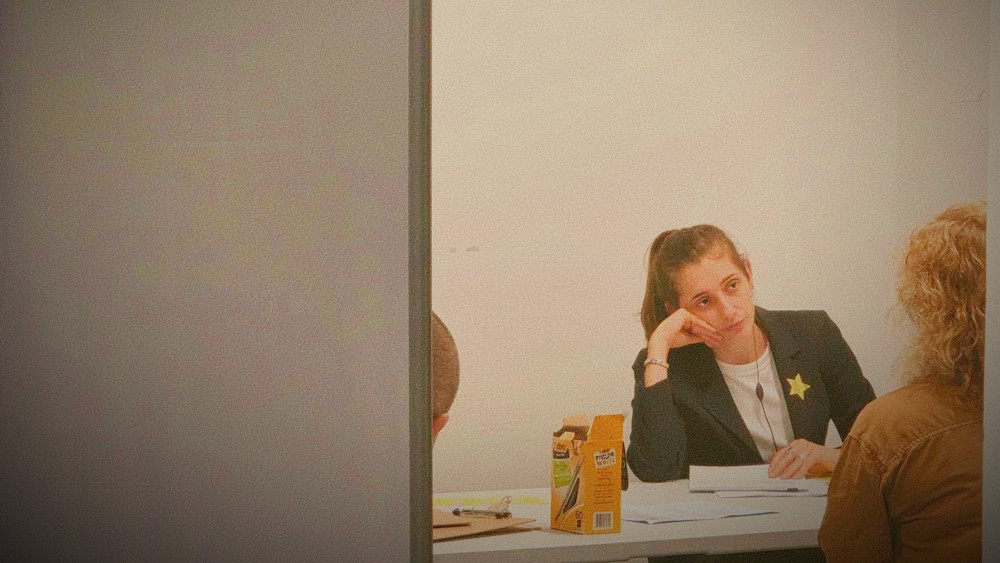As summer began to give way to fall in September and October, Propsect Park became the venue for The Last Stand, a new experimental opera from well-known composer Kamala Sankaram, an alum of The Civilians R&D Program. Near the music pagoda west of the Nethermead, park visitors could stop and listen to the sound installation which won the 2021 Emerging Artist Open Call from Creative Time. Sankaram’s composition documents the life of the Mother Tree, a nearly 300 year old oak in upstate New York’s Black Rock Forest. Sankaram crafted a 10-hour sonic journey using her field recordings; it takes audiences through the tree’s life from acorn to “last stand,” its last push of energy into the forest’s network. Sankaram also uses her scientific research to communicate to the installation’s local trees through vibrations, creating an experience for two audiences: human and flora.
For Kamala, the idea originated in conversations with her sister, but the piece evolved significantly over time. “I knew from the beginning that I wanted to ground the piece more firmly in the actual science, specifically around the question of what might be “musical” for a tree,” Sankaram said in our interview. She started by researching tree communication and how plants respond to sound, developing a better understanding through reading journal articles and speaking with researchers at the forefront of studying these and relevant topics. “These conversations were what caused my thinking about the piece to change and directly led to what the piece ended up becoming. So, I think that I moved away from the initial concept pretty quickly, though there were certain things that remained the same: I always knew the piece needed to be very long (from a human perspective) and I knew the piece would involve a center tree standing in for the protagonist (which became the white oak) with an audience of trees in a circle around the periphery.”
Researching the scientific foundations of her concept clarified Sankaram’s vision for the piece; documenting the soundscapes was the next step. Sankaram shared that “the biggest challenge for me was that I didn’t have a lot of experience doing true field recording. In my previous work with found sound, I’ve been able to do the recording indoors, which gives you a greater degree of control. When you’re in a forest, you’re dealing with wind, insects, and the fact that you can only carry a certain amount of gear (especially if you’re hiking). You’re also at the mercy of your battery power and need to make sure you have back-up batteries.” Working in the field was more than a series of new challenges, however; the experience also gave her a number of pleasant surprises. She explained that “the best part about it was that in doing a field recording and having that lack of control you also end up with sounds that you might not have thought about trying to find. For example, on one of my early outings in the woods, there were no leaves on the trees yet, so the sound echoed in a really magical way. There were three different woodpeckers hammering away from far points in the trees. And then a hawk cried out from overhead, very close by. It’s not something I could have planned– it was just a lucky coincidence that I happened to be there in that moment.”

Once Sankaram gathered her field recordings, she began to work on composing. For her, “the first step in the compositional process was to listen back to all of the hours of field recording to see what I had.” Thankfully, Sankaram already had a structure in mind for the composition to arrange the sounds around. Since the opera follows the life of the Mother Tree and the natural environment, the marking of the passage of time was naturally built into the composition. “I knew that I would structure the piece in smaller segments corresponding to the years of the tree’s life. Each year would be two minutes long, based on the formula of 30s per season. Within each year, there I planned to include the sounds of the various stages of the leaves as they grow and die in the spring, summer, and autumn. The sound of winter would not have any animal sounds (only ice cracking and the creak of the trees). So, the animal sounds would need to make a complete musical phrase that lasted about a minute and a half for each year.” Developing a structure was only part of the artistic process, however, for Sankaram to transform the documentary soundscape into a sonic journey. “As I listened, I started to hear patterns that were rhythmic or melodic. These became the basis of each phrase. I would then use the base sound to create a tempo map. I layered other sounds on top of this tempo map without changing their pitch or basic rhythmic pattern. Most of it was done by feel, getting a sense of which sounds might work together and then layering them.”
Putting the natural environment at the center of the work also guided the development of the physical space for the installation. Tucked well into Prospect Park, the location was one that could be intentionally found by audiences or easily stumbled upon by park visitors. Situated under a canopy of towering trees, simple constructions from unfinished 2×4 wood planks snaked around and between several tree trunks and offered audiences places to sit and lean while listening. In speaking with Sankaram more about the installation itself, she provided insight into the concept behind the design of the physical space of the installation. “The set came out of a series of conversations with Darling Green. I knew that I wanted the set to feel organic,” she said. For Sankaram, the set needed to balance its human and flora audiences. The opera was designed to communicate with the trees of Propsect Park and Sankaram knew the set needed “to teach the audience how to engage with the piece.” This focus was evident from the obtuse angle of the set that naturally guided audiences, seated or leaning, to look upwards at the trees and tree canopy. Sankaram also pointed out some of the nuances of the set’s design, detailing that “each of the trees in the stand had a dedicated set of speakers and a sound wall that wrapped around the tree. The tree in the center (standing in for the oak tree) was encircled by the speakers, creating almost a throne. Finally, the inclusion of a vibrational element was very important, both to simulate the way that a tree experiences sound, but also to create better access for the deaf and hard of hearing community. The set needed to be constructed in such a way as to allow the vibrations to be felt, which using a continuous seat made of wood allowed.” Interestingly, the set was not designed with the idea that audiences would lean – those parts of the set were actually the sound walls that wrapped around the trees. “We didn’t expect people to lean on the sound walls,” Sankaram shared, “but it was delightful to see.”

How audiences would interact with the public installation factored into several of Sankaram’s decisions for the composition. “I had originally thought that I might just use the soundscapes I captured from the forest and put them in the park,” she shared. “But because the installation would be in counterpoint with the natural sounds of the park, I quickly changed my approach to thinking about how to create sounds that were hyperreal, that seemed to emerge from the texture of the park, but that were magical and impossible: frogs calling in perfectly rhythmic chorus, nightbirds and songbirds singing together, and so on.” Sankaram’s focus on highlighting that tension between the installation’s and its natural environment paid off. “What is interesting is that I heard from several people that they began listening with intention, trying to tell what was real and what wasn’t.” This level of attention is something I can also personally attest to. In my hours at the installation, I heard two women trying to identify particular animals and birds in recorded and used in the composition. For Sankaram, the attention to the details of one’s soundscape meant she had accomplished one of her ambitions for the piece. “Most exciting for me, this intentional listening continued even when they left the installation, which was really my hope: to find a way for us to engage more fully with the world around us.”
Another goal for her was to affect how human audiences related to the natural audience in regards to our perspectives on time. “It was very important to me that the sense of the time scale was part of the experience, that the audience could consider their own perspective of time as opposed to the tree’s. Since the composition was based on the cycle of seasons and years, the overall flow of the piece is also based on what the forest might sound like between the years 1750-2050, and how that changes over time.” That larger slice of time allowed for Sankaram to also work towards one of her final goals for the piece: highlighting the effects of humans on the natural environment. Noticing this change, however, may not be possible for all audiences depending on how long and what portions of the opera they hear. “The change is gradual at first but becomes more apparent the later we get into the piece as human influence increases,” Sankaram explained. “So, someone coming in the morning will hear different things than someone coming in the afternoon, but they won’t know the difference unless they come back several times (or stay for the duration). You do notice the change if you come in the last hour (or even the last 15 minutes).” However, the opera lasts 10 hours and Sankaram had to consider how partial interactions with the piece could still affect the audience. She answered “my thought was that even if a person doesn’t stay, simply being aware of the fact that the piece is ten hours longs could expand their thinking.”
Sankaram’s composition openly invites its human audience to find a sympathetic understanding with its partner audience, the trees, and its goals to expand how humans think about and interact with the natural environment prompts us also to action regarding the climate crisis. The composition includes disasters of the natural, human, and human-influenced varieties. The Last Stand asks us to listen to the catastrophic effects of climate change as it projects into the future to the year 2050, 300 years after the birth of the Mother Tree, and pay attention to our role in the ecosystem. Unlike many works of art about the climate crisis, Sankaram’s opera asks a series of simple questions: Listen. What do you hear? What have we gained? And what are we losing?
Want to learn more about The Last Stand? Read more about the installation in the digital program and listen to podcast episodes with Kamala Sankaram and a host of experts from the sciences, the arts, nature conservation, and organizing backgrounds. Interested in learning more about our environment, plant networks, or tree communication? Check out the suggested reading list.
Extended Play is a project of The Civilians. To learn more about The Civilians and to access exclusive discounts to shows, visit us and join our email list at TheCivilians.org.
Author
-

Leah Putnam (she/her) is a dramaturg from outside of Philadelphia, Pennsylvania. Prior to joining The Civilians, she worked as a dramaturg for Live Arts in Charlottesville, Virginia and has worked on developing new work with writers including LET GO OF ME by Kelley Van Dilla. She is particularly passionate about immersive theater and also has a background in costumes. Leah completed her MA in English at UVA and her BA in English at NYU.
View all posts










